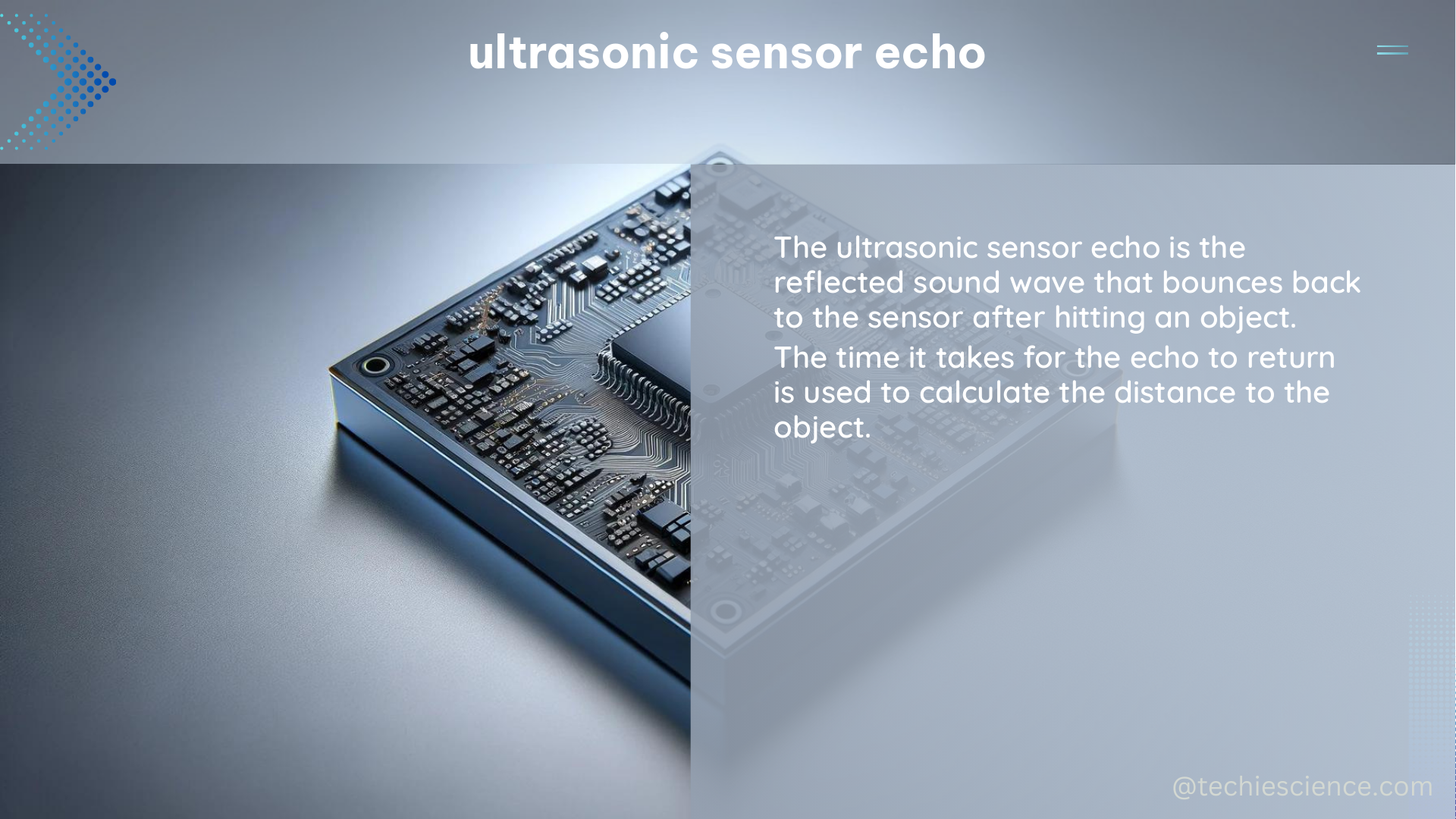The ultrasonic sensor echo is a crucial aspect of distance measurement using ultrasonic sensors. It is the time taken for the ultrasound wave to travel to an object and back, which is used to calculate the distance. The HC-SR04 ultrasonic sensor, a popular choice for distance measurement, operates at a frequency of 40kHz and can measure distances ranging from 2cm to 400cm with an accuracy of 3mm.
Understanding the Ultrasonic Sensor Echo
The echo pin of the HC-SR04 sensor outputs a high signal when it detects the ultrasound wave’s reflection from an object. The duration of this high signal corresponds to the time taken for the ultrasound wave to travel to the object and back. By measuring this duration, one can calculate the distance to the object using the speed of sound and the time taken. The formula for calculating distance is:
Distance = (Speed of Sound x Time) / 2
Where the speed of sound is 340m/s, and the time is the duration of the high signal on the echo pin.
Ensuring Accurate Measurements

To ensure accurate measurements, it is essential to use the correct voltage levels for the sensor. The HC-SR04 sensor requires a 5V input and outputs 5V to the GPIO pins. However, it is recommended to use a voltage divider to bring the ECHO pin voltage down to 3.3V for compatibility with devices like the ESP8266, which have a strong recommendation to use 3.3V into the GPIO pins.
When measuring the echo pin’s voltage, it is essential to use an oscilloscope instead of a multimeter. A multimeter may not be able to accurately measure the peak signal of a pulsed line, while an oscilloscope can provide a more accurate measurement of the echo pin’s voltage.
Factors Affecting Ultrasonic Sensor Accuracy
While the HC-SR04 sensor is a popular choice for distance measurement, it is essential to consider the sensor’s limitations. The sensor’s wide angle of ultrasonic beam and physical surroundings can significantly affect the sensor’s accuracy. The angle of the ultrasonic beam can cause reflections from nearby objects, leading to inaccurate distance measurements.
The physical surroundings of the sensor can also impact its accuracy. Obstacles, surfaces, and materials in the sensor’s path can affect the ultrasound wave’s reflection, resulting in incorrect distance calculations. For example, soft, absorbent materials like foam or fabric may not reflect the ultrasound wave as effectively as hard, reflective surfaces like metal or concrete.
Maximizing Sensor Range and Calibration
Another critical aspect to consider is the sensor’s maximum range of 400cm. If the measured distance exceeds this range, the sensor may not provide accurate measurements. It is essential to consider the sensor’s maximum range and adjust the measurement settings accordingly.
Additionally, the HC-SR04 sensor is an analog device, and its output is affected by temperature and humidity. Therefore, it is recommended to calibrate the sensor under the same environmental conditions as the measurement to ensure accurate measurements. This can be done by comparing the sensor’s output with a known reference distance and adjusting the sensor’s settings accordingly.
Practical Applications and Considerations
The ultrasonic sensor echo has a wide range of practical applications, including:
- Robotics and Automation: Ultrasonic sensors are commonly used in robotic systems for obstacle detection, navigation, and proximity sensing.
- Home Automation: Ultrasonic sensors can be used in smart home applications for features like automatic door opening, security systems, and pet monitoring.
- Industrial Automation: Ultrasonic sensors are used in industrial applications for level measurement, object detection, and process control.
- Automotive: Ultrasonic sensors are used in vehicles for features like parking assistance, blind spot detection, and collision avoidance.
When using ultrasonic sensors in these applications, it is essential to consider the sensor’s limitations and optimize the measurement settings to ensure accurate and reliable performance.
Conclusion
The ultrasonic sensor echo is a critical aspect of distance measurement using ultrasonic sensors. The HC-SR04 sensor is a popular choice for distance measurement, operating at 40kHz and measuring distances ranging from 2cm to 400cm with an accuracy of 3mm. To ensure accurate measurements, it is essential to use the correct voltage levels, measure the echo pin’s voltage using an oscilloscope, and calibrate the sensor under the same environmental conditions as the measurement.
By understanding the factors that affect the ultrasonic sensor echo and implementing the appropriate techniques, you can maximize the accuracy and reliability of your distance measurement applications.
References:
– HC-SR04 ultrasonic sensor: How to check voltage on the ECHO pin – Arduino Stack Exchange
– Ultrasonic Sensor HC-SR04 and Arduino – Complete Guide – How To Mechatronics
– Ultrasonic sensor programming questions – Arduino Forum
– Ultrasonic sensor HC-SR04 delivers wrong distance – Arduino Forum

The lambdageeks.com Core SME Team is a group of experienced subject matter experts from diverse scientific and technical fields including Physics, Chemistry, Technology,Electronics & Electrical Engineering, Automotive, Mechanical Engineering. Our team collaborates to create high-quality, well-researched articles on a wide range of science and technology topics for the lambdageeks.com website.
All Our Senior SME are having more than 7 Years of experience in the respective fields . They are either Working Industry Professionals or assocaited With different Universities. Refer Our Authors Page to get to know About our Core SMEs.